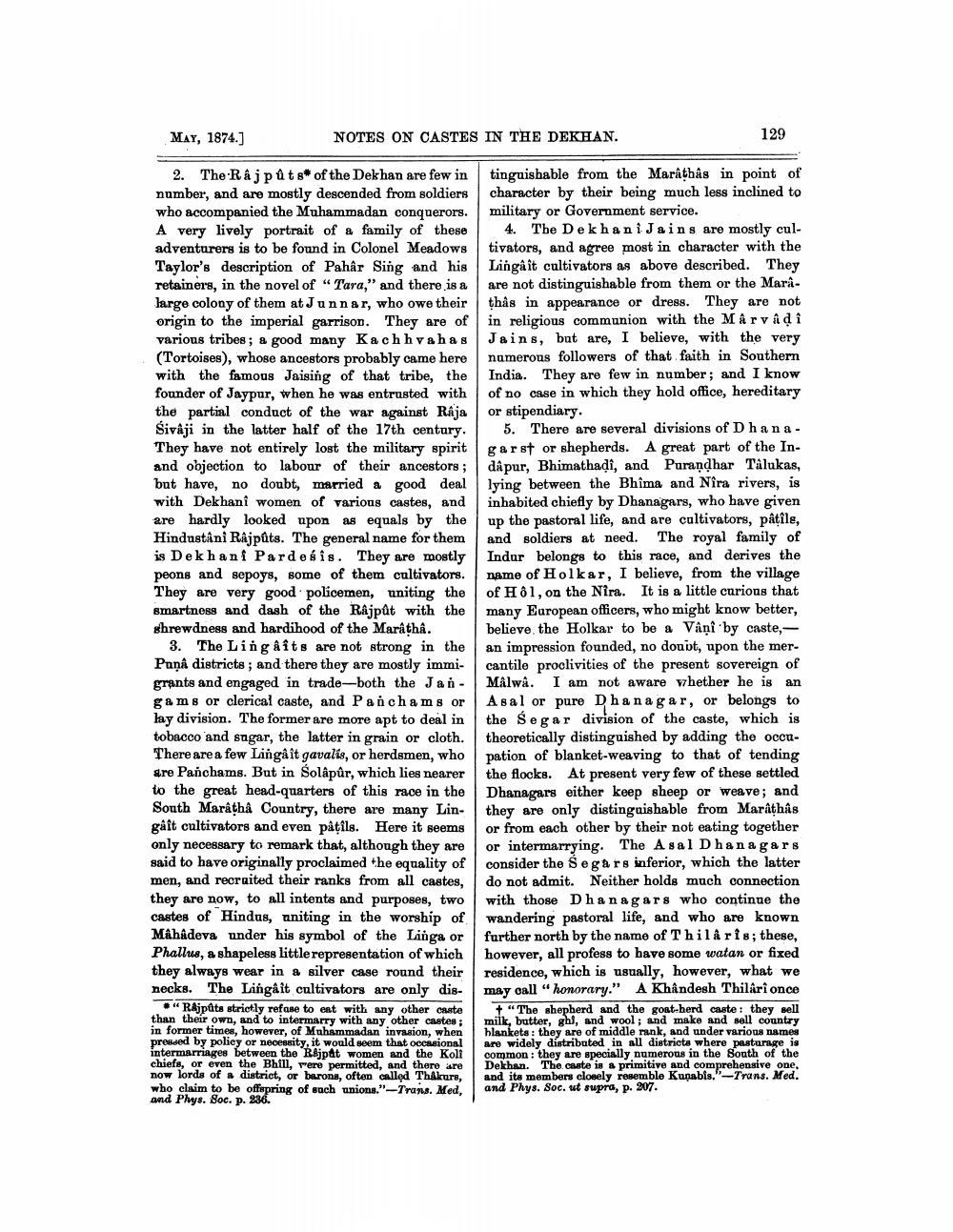________________
MAY, 1874.]
NOTES ON CASTES IN THE DEKHAN.
129
2. The Rajput of the Dekhan are few in tinguishable from the Marathas in point of number, and are mostly descended from soldiers character by their being much less inclined to who accompanied the Muhammadan conquerors. military or Government service. A very lively portrait of a family of these 4. The Dekhani Jains are mostly culadventurers is to be found in Colonel Meadows tivators, and agree most in character with the Taylor's description of Pahar Sing and his Lingâît cultivators as above described. They retainers, in the novel of “Tara," and there is a are not distinguishable from them or the Maralarge colony of them at Junnar, who owe their thås in appearance or dress. They are not origin to the imperial garrison. They are of in religious communion with the Marvad i various tribes; a good many Kach hva has Jains, but are, I believe, with the very (Tortoises), whose ancestors probably came here namerous followers of that faith in Southern with the famous Jaising of that tribe, the India. They are few in number; and I know founder of Jaypur, when he was entrusted with of no case in which they hold office, hereditary the partial conduct of the war against Raja
st of the war against Raja or stipendiary. Sivaji in the latter half of the 17th century. 5. There are several divisions of Dhana - They have not entirely lost the military spirit garst or shepherds. A great part of the Inand objection to labour of their ancestors; dapur, Bhimathadi, and Purandhar Talukas, but have, no doubt, married a good deal lying between the Bhîma and Nîra rivers, is with Dekhani women of various castes, and inhabited chiefly by Dhanagars, who have given are hardly looked upon as equals by the up the pastoral life, and are cultivators, patile, Hindustani Rajpûts. The general name for them and soldiers at need. The royal family of is Dekhani Pardesis. They are mostly Indur belongs to this race, and derives the peons and sepoys, some of them cultivators. name of Holkar, I believe, from the village They are very good policemen, uniting the of Hôl, on the Nîra. It is a little curious that smartness and dash of the Rajput with the many European officers, who might know better, shrewdness and hardihood of the Maratha. believe the Holkar to be a Vâni by caste,
3. The Lingaits are not strong in the an impression founded, no doubt, upon the merPaņa districts; and there they are mostly immi- cantile proclivities of the present sovereign of grants and engaged in trade-both the Jan- Målwa. I am not aware whether he is an gams or clerical caste, and Panchams or Asal or pure Dhanagar, or belongs to lay division. The former are more apt to deal in the segar division of the caste, which is tobacco and sagar, the latter in grain or cloth. theoretically distinguished by adding the occuThere are a few Lingå it gavalis, or herdsmen, who pation of blanket-weaving to that of tending are Panchams. But in Solapur, which lies nearer the flocks. At present very few of these settled to the great head-quarters of this race in the Dhanagars either keep sheep or weave; and South Marathả Country, there are many Lin-| they are only distinguishable from Marathas gâft cultivators and even påtils. Here it seems or from each other by their not eating together only necessary to remark that, although they are or intermarrying. The Asal Dhanagars said to have originally proclaimed the equality of consider the Segare inferior, which the latter men, and recruited their ranks from all castes, do not admit. Neither holds much connection they are now, to all intents and purposes, two with those Dhanagars who continue the castes of Hindus, uniting in the worship of wandering pastoral life, and who are known Mahadeva under his symbol of the Linga or further north by the name of Thilaris; these, Phallus, a shapeless little representation of which however, all profess to have some watan or fixed they always wear in a silver case round their residence, which is usually, however, what we necks. The Lingait cultivators are only dis- may call "honorary." A Khandesh Thilari once
"Rajputs strictly refuse to eat with any other caste + "The shepherd and the goat-herd caste: they sell than their own, and to intermarry with any other castes; milk, butter, gh, and wool; and make and sell country in former times, however, of Muhammadan invasion, when hlankets: they are of middle rank, and under various names pressed by policy or necessity, it would seem that occasional are widely distributed in all districts where pastorage is intermarriages between the Rajpat women and the Koli common: they are specially numerous in the south of the chiefs, or even the Bhill, rere permitted, and there are Dekhan. The caste is a primitive and comprehensive one, now lords of district, or barons, often called ThAkurs, and its members closely resemble Kunabis."--Trans. Med. who claim to be offspring of such unions." -Trans. Med, and Phys. Soc. ut supra, p. 207. and Phys. Soc. p. 236.




